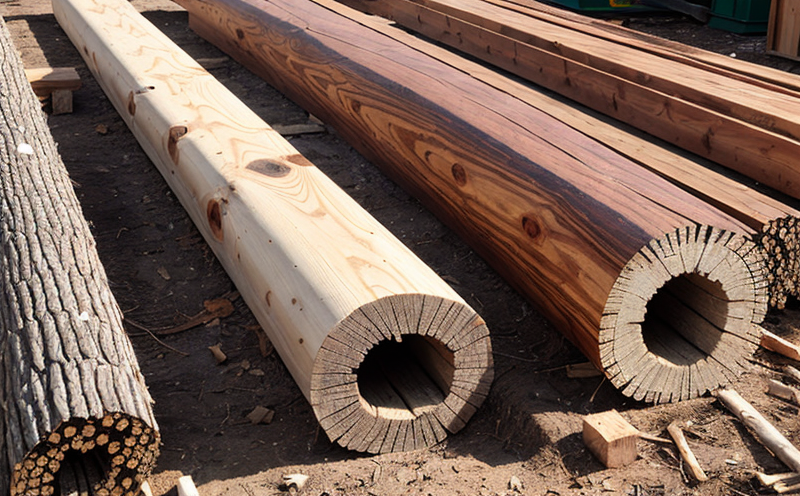Abrasion Resistance Testing of Treated Wood Surfaces
The abrasion resistance testing of treated wood surfaces is a critical process in quality management and compliance within the agriculture and forestry sector. This test evaluates the durability and longevity of wood products that have undergone treatment for protection against environmental factors such as moisture, insects, fungi, and decay. The abrasion resistance test specifically assesses how well these treated wood surfaces withstand wear due to friction or mechanical action.
In sectors like construction, where exposed wooden components are subject to constant abrasion from weather elements and physical contact, this testing is essential for ensuring long-lasting performance and reliability of materials. For R&D engineers and quality managers, understanding the abrasion resistance properties helps in selecting appropriate treatments that enhance wood durability without compromising on aesthetic or functional qualities.
Wood preservation involves various treatment methods aimed at extending the service life of wooden structures. These treatments often include chemical preservatives, biocides, or other protective coatings. However, these applied treatments can also affect the natural texture and finish of the wood, making abrasion resistance testing crucial to determine if the protection provided by these treatments comes at the cost of reduced durability.
The importance of this test lies in its ability to balance protection and performance. By quantifying how well treated wood surfaces resist wear over time, manufacturers can optimize their treatment processes for better results. Compliance officers ensure that all products meet regulatory standards set forth by organizations such as ASTM International or ISO (International Organization for Standardization), which provide guidelines on acceptable levels of abrasion resistance.
For procurement teams involved in sourcing treated wood materials, knowing the abrasion resistance properties helps them make informed decisions about suppliers and product specifications. This knowledge enables them to select high-quality products that not only meet regulatory requirements but also perform well under real-world conditions.
The abrasion resistance test typically involves exposing a sample of treated wood to controlled frictional forces using specialized equipment designed for this purpose. The degree of wear is then measured based on predefined criteria, allowing for consistent comparison between different samples or over time as part of quality control measures.
Understanding the abrasion resistance properties of treated wood surfaces provides valuable insights into their overall performance and longevity. This information is particularly useful when developing new products or improving existing ones in terms of both protection and usability.
| Standard | Description |
|---|---|
| ASTM D3270-18 | Procedure for Abrasion Resistance of Wood and Wood Products |
| ISO 6946:2015 | Test Methods for Abrasion Resistance of Solid Timber Flooring |
Why It Matters
The abrasion resistance testing of treated wood surfaces is significant because it directly impacts the durability and performance of wooden structures in various applications. In agriculture, for instance, fences made from treated wood need to withstand harsh weather conditions while also being resistant to frequent handling by animals or workers. Similarly, in forestry, poles used for support or decoration must be able to resist wear caused by natural elements like wind, rain, and sun exposure.
For construction projects involving exterior wooden components such as decks, siding, or railing systems, ensuring adequate abrasion resistance ensures that these structures remain intact and visually appealing even after years of use. Without proper abrasion testing, there is a risk that treated wood may deteriorate prematurely due to mechanical wear, leading to costly replacements and maintenance costs.
From an environmental perspective, promoting the use of durable treated wood can contribute positively towards sustainable practices by reducing waste from frequent replacement of damaged or worn-out components. Additionally, it supports efforts aimed at conserving natural resources through efficient utilization of materials that have been enhanced with protective treatments.
In summary, conducting thorough abrasion resistance testing ensures that treated wood surfaces meet both functional and aesthetic expectations across diverse industries. It contributes to creating safer, more sustainable environments while promoting innovation in product development and quality assurance processes.
Applied Standards
| Standard | Description |
|---|---|
| ASTM D3270-18 | Procedure for Abrasion Resistance of Wood and Wood Products |
| ISO 6946:2015 | Test Methods for Abrasion Resistance of Solid Timber Flooring |
| EN 335-1:2007 | Wood Preservatives - Part 1: General Requirements and Classification |
| IEC 62849-2006 | Environmental Conditions for Electrical Equipment - Exposure to Outdoor Air |
The application of these standards ensures that the abrasion resistance testing adheres to internationally recognized protocols, providing reliable and consistent results. Compliance with such standards is essential for manufacturers who wish to ensure their products meet industry benchmarks.
Scope and Methodology
| Test Parameters | Description |
|---|---|
| Type of Abrasion Test | The test uses a rotating drum with abrasive materials to simulate real-world conditions experienced by treated wood surfaces. |
| Sample Preparation | Samples are cut into standardized sizes and shapes, ensuring uniformity across all samples being tested. The surfaces must be clean and dry before testing begins. |
| Testing Conditions | The test is conducted at ambient temperature controlled within a specific range to simulate typical environmental conditions. Specimens are exposed to the rotating drum for a predetermined duration, typically ranging from 50 to 200 revolutions depending on the application and expected wear. |
| Data Collection | After testing, the specimens are weighed to measure any loss in mass due to abrasion. Additional measurements may include surface roughness or change in coloration if applicable. |
The methodology employed ensures accurate and reproducible results, allowing for meaningful comparisons between different samples or treatments over time. The use of controlled conditions helps eliminate variables that could otherwise affect the outcome of the test.
Quality managers and compliance officers rely on these precise methods to ensure that treated wood surfaces meet stringent quality standards. This approach not only enhances the reliability of products but also supports continuous improvement efforts in material science research and development.





